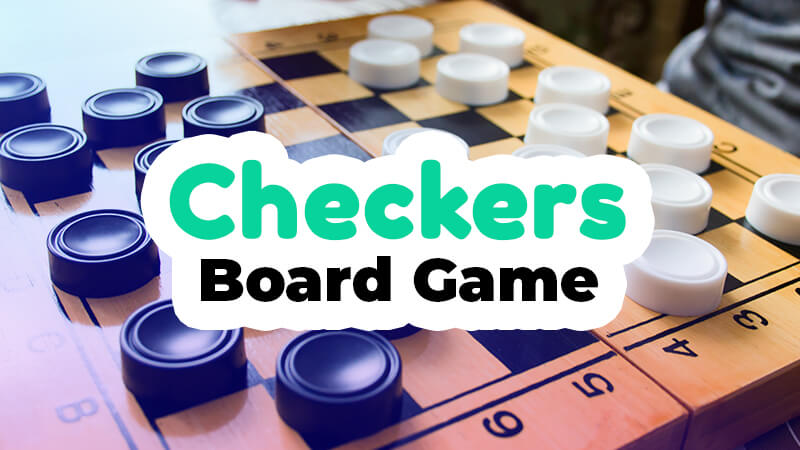Checkers Board Game Rules

Table of Contents
Checkers, along with other famous board games like Backgammon, is one of the oldest games in the world, believed to have been played in 3000 BC. Of course, the game rules might have been different back then, but it’s astonishing how long this game persisted through the pressure of time. It is played with two people and a board.
Here at VIP Games, we’ve got your back if you’re just starting out with checkers. Our blog post covers all things checkers, from the board setup to the clever moves and awesome strategies.
How to set up a Checkers board
1. Set up the board. Sit across from your opponent and place the board between you two. The board is made up of 64 alternating dark and light squares in 8 rows of 8. There are 32 light squares and 32 dark squares. Place the board so that each player has a light-colored square on the corner of the board on their right side.
2. Place the checkers on the board. Players position their 4 checkers on the first three rows, aligning with the 12 dark squares closest to them. Movement is restricted to diagonal directions on these squares. With 8 rows on the board, 6 are occupied by players’ checkers, leaving two central rows unoccupied.
3. Decide if you’ll time the moves. Tournament checkers grant each player a 5-minute window per move. Timing each move ads a layer of competitiveness. If you’d like to time your game, place a timer on the side of the board.
4. Determine who will have the first turn. Prior to arranging the board, determine the starting player – this can be the victor of the previous game, a coin flip, or any agreed method. The player taking the black checkers goes first, as per checkers’ convention.
How to Play Checkers
Now that the board is set and the players are ready, it’s time to play Checkers!
The black checkers start the game
After you’ve decided who will be going first, the first player takes the black checkers. Each turn allows moving one checker diagonally toward your opponent on dark squares. After the initial black checker move, alternate turns with the white side.
Jump your opponent’s checkers
When your checker resides diagonally next to an opponent’s, you could jump and capture it. You can do this by moving two diagonal spaces towards their checker, as if hopping over. The target space must be vacant. If a jump is possible, it’s obligatory. Multiple jumps are permissible, with your choice of order. If a new position enables another capture, continue jumping until no more captures are possible.
King your pieces
Crowning a checker as king is as simple as placing one of your captured pieces on top. Kings can move diagonally both forward and backward on dark squares, enhancing capture potential. In non-capture moves, kings move one diagonal space. During captures, kings can move forward and backward within the same turn, necessary for changing directions mid-capture. For instance, capturing horizontally aligned checkers on dark squares. Some sets indicate kings with a crown on the back, and there’s no limit to crowning pieces.
Repeat to end the game
Continue capturing your opponent’s checkers until they’re entirely off the board. Once every of your opponent’s checkers are gone, you are the victor. Alternatively, a rarer win results from blocking all your opponent’s pieces, rendering them immobile and unable to continue.
How to win at Checkers
You might not win at checkers every single time, but practice definitely helps you become a better player. Here are some useful tips:
Play the offence
Novices might lean towards keeping their pieces along the board’s edges, avoiding the opponent’s checkers. However, it’s wiser to focus on capturing their checkers than overly protecting your own. Accept some losses if you can gain more from capturing. Embrace boldness, actively pursuing your opponent’s checkers for capture opportunities.
Move your pieces together
Moving a single checker forward without support makes it susceptible to capture. Create a blockade by grouping some checkers together instead. The center of the board is ideal for a protective cluster while advancing. Avoid shifting all checkers to the center, hindering mobility. Grouping checkers makes them less vulnerable to capture. If your opponent does capture, having a piece ready for retaliation is advantageous.
Keep a full back row for as long as you can
Should your opponent reach your back row, their piece will become a king, harder to capture. A full back row prevents their promotions and simplifies capturing their approaching pieces.
Sacrifice pieces strategically
When leading or tied, don’t hesitate to sacrifice a piece to recapture your opponent’s or gain position. Sustain momentum and safeguard your king, prioritizing it over regular checkers. Optimize exchanges, offering one piece for two opponent pieces, maintaining a strategic advantage.
Focus on the kings
Prioritize crowning your pieces and preventing your opponent’s promotions as the game progresses. However, avoid crowning if it leads to substantial checker losses. Strategically time when to promote your pieces for optimal results.
You can also read our article about the backgammon setup.
Subscribe now
Receive updates and latest news about VIP Games. Simply enter your email below and get notified!
You will only receive quality content.
Signing up for newsletters indicates you agree with our Privacy Policy. If you decide that you no longer want to receive a newsletter, you can unsubscribe by clicking the “Unsubscribe” link, located at the bottom of each newsletter.
